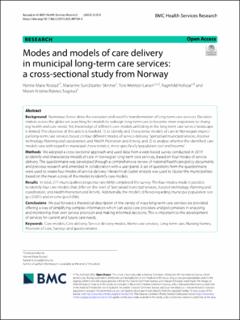| dc.contributor.author | Rostad, Hanne Marie | |
| dc.contributor.author | Skinner, Marianne Sundlisæter | |
| dc.contributor.author | Wentzel-Larsen, Tore | |
| dc.contributor.author | Hellesø, Ragnhild | |
| dc.contributor.author | Sogstad, Maren Kristine Raknes | |
| dc.date.accessioned | 2023-11-02T10:27:59Z | |
| dc.date.available | 2023-11-02T10:27:59Z | |
| dc.date.created | 2023-08-01T09:38:41Z | |
| dc.date.issued | 2023 | |
| dc.identifier.issn | 1472-6963 | |
| dc.identifier.uri | https://hdl.handle.net/11250/3100226 | |
| dc.description.abstract | Background
Numerous forces drive the evolution and need for transformation of long-term care services. Decision-makers across the globe are searching for models to redesign long-term care to become more responsive to changing health and care needs. Yet, knowledge of different care models unfolding in the long-term care service landscape is limited. The objective of this article is twofold: 1) to identify and characterise models of care in Norwegian municipal long-term care services based on four different modes of service delivery: Specialised municipal services, Assistive technology, Planning and coordination, and Health Promotion and Activity, and 2) to analyse whether the identified care models vary with regard to municipal characteristics, more specifically ‘population size’ and ‘income’.
Methods
We adopted a cross-sectional approach and used data from a web-based survey conducted in 2019 to identify and characterize models of care in Norwegian long-term care services, based on four modes of service delivery. The questionnaire was developed through a comprehensive review of national healthcare policy documents and previous research and amended in collaboration with a user panel. A set of questions from the questionnaire were used to create four modes of service delivery. Hierarchical cluster analysis was used to cluster the municipalities based on the mean scores of the modes to identify care models.
Results
In total, 277 municipalities (response rate 66%) completed the survey. The four modes made it possible to identify four care models that differ on the level of Specialised municipal services, Assistive technology, Planning and coordination, and Health Promotion and Activity. Additionally, the models differed regarding municipal population size (p < 0.001) and income (p = 0.006).
Conclusions
We put forward a theoretical description of the variety of ways long-term care services are provided, offering a way of simplifying complex information which can assist care providers and policymakers in analysing and monitoring their own service provision and making informed decisions. This is important to the development of services for current and future care needs. | en_US |
| dc.language.iso | eng | en_US |
| dc.publisher | BMC | en_US |
| dc.rights | Navngivelse 4.0 Internasjonal | * |
| dc.rights.uri | http://creativecommons.org/licenses/by/4.0/deed.no | * |
| dc.title | Modes and models of care delivery in municipal long-term care services: a cross-sectional study from Norway | en_US |
| dc.title.alternative | Modes and models of care delivery in municipal long-term care services: a cross-sectional study from Norway | en_US |
| dc.type | Peer reviewed | en_US |
| dc.type | Journal article | en_US |
| dc.description.version | publishedVersion | en_US |
| dc.source.volume | 23 | en_US |
| dc.source.journal | BMC Health Services Research | en_US |
| dc.identifier.doi | 10.1186/s12913-023-09750-8 | |
| dc.identifier.cristin | 2164179 | |
| cristin.ispublished | true | |
| cristin.fulltext | original | |
| cristin.qualitycode | 2 | |

